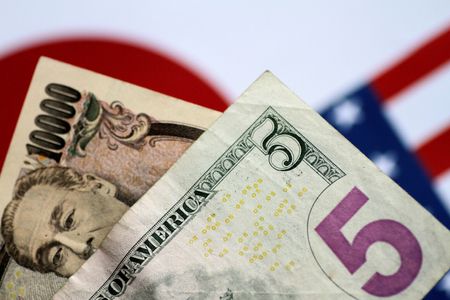
By Kevin Buckland and Georgina Lee
TOKYO (Reuters) – The dollar scaled new 24-year heights on the yen on Wednesday, breaching levels that prompted intervention by Japanese officials last month, while investors in sterling were scratching their heads about the Bank of England’s plans.
The dollar reached as high as 146.39 yen in early Asia trade, the first time at that level since August 1998. It was last up 0.2% at 146.18.
Japanese authorities staged their first yen-buying intervention since 1998 on Sept. 22, when the yen weakened to 145.90 per dollar.
Officials have reiterated they remain ready to take appropriate steps to counter excessive currency moves, though whether they wish to defend particular levels is less clear.
“Given the overriding strong dollar trend in place, it’s possible that instead of defending the yen at a particular level, the Bank of Japan would try to slow down the pace of the dollar-yen’s rise by defending at a higher level” than previously, said Alvin Tan, head of Asia currency strategy at RBC Capital Markets.
The Japanese currency is particularly sensitive to the gap between U.S. and Japanese long-term bond yields. The benchmark 10-year Treasury yield jumped to the cusp of a 14-year high overnight at 4.006%, while the equivalent Japanese government bond yield is pinned near zero by the Bank of Japan.
The other main focus of the day was sterling, which slipped to a new two-week trough of $1.0925 in early Asia trade after Bank of England (BoE) Governor Andrew Bailey reiterated that the central bank would end its emergency bond-buying programme on Friday and told pension fund managers to finish rebalancing their positions within that time frame.
It rebounded slightly after a report in the Financial Times said the BoE has signalled privately to lenders that it was prepared to prolong its bond purchases, and was last at $1.1015, up 0.5% on the day
“Confusing much?” Jordan Rochester, executive director of FX strategy summarised the situation in emailed comments.
“Either way it’s a stop gap and eventually will come to an end, it has allowed GBP some respite but it’s not a reason in itself to go long GBP. It’s simply a matter of time before the support for the long end is reduced and GBP heads lower with it,” Rochester added.
The emergency programme was a response to turmoil in Britain’s government bond market following a mini-budget that also sent the pound to a record low of $1.0327.
Wednesday data showing Britain’s economy shrank by 0.3% in August, hit by weakness in manufacturing and maintenance work in North Sea oil and gas fields just, to the confusion.
Elsewhere, the euro slumped to its weakest since Sept. 29 overnight at $0.9670 and remained not far from that level, trading flat on the day at $0.9715.
Traders are watching European Central Bank President Christine Lagarde’s speech at the IIF annual meeting in Washington for any signals about euro zone rate increases.
The risk-sensitive Australian dollar sank to a 2 1/2-year low of $0.62395.
(Reporting by Kevin Buckland and Georgina Lee; Additional reporting by Vidya Ranganathan, Alun John; Editing by Shri Navaratnam, Robert Birsel)

